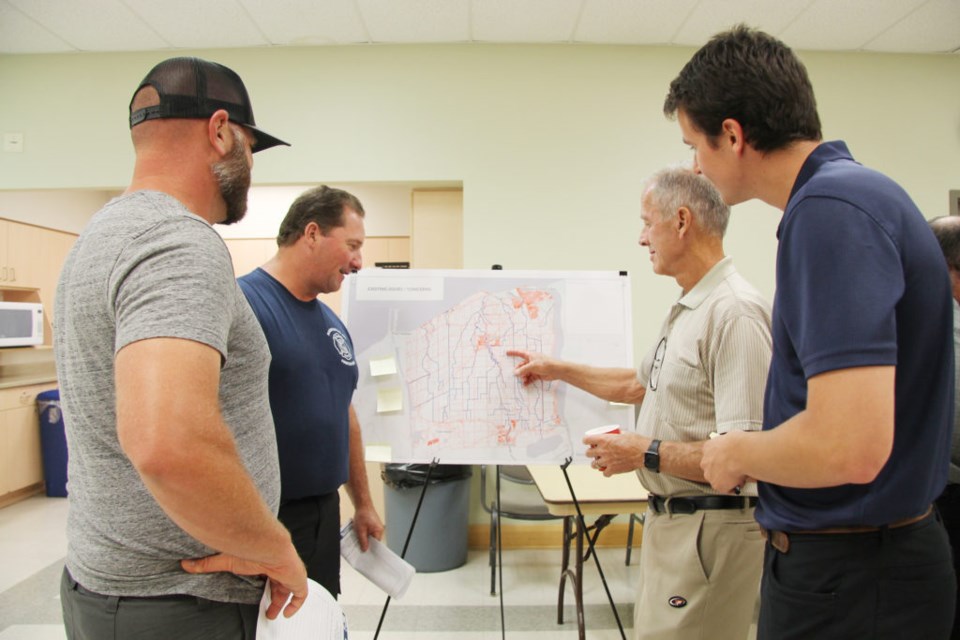
Area farmers were given an opportunity last week to talk about the 25-year system they depend on for irrigation.
A local engineering company has been retained to compile the information and report to the town.
The purpose of the Irrigation Systems Strategy to be developed, with help from Associated Engineering, is to improve customer service, support long-term growth and sustainability of the system, maintain the aging system and ensure it remains sustainable through times of drought.
Brett Ruck, the Town’s irrigation and drainage superintendent, says there are 126 permit holders drawing water, with 7,000 acres of land that can use the irrigation system at once.
There are five intakes supplying water to the irrigation system with the three water bodies, the Welland Canal, the Niagara River and the Ontario Power Generation Canal and Reservoir.
The three primary delivery areas amount to 8,300 acres and are delineated by the town from east to west, including Harrison/Routh, Four Mile Creek and Airport-Bright Lavigne.
Of the permit holders, so far, about 21 participated in the stakeholder consultation survey implemented by Associated Engineering.
Ruck says it’s important to have as many permit holders as possible complete the survey and provide feedback to help him get funding from the Province.
He added this could help offset costs that are absorbed by those who use the system. “It is not a service the Town pays for.”
The direction of the irrigation system has been at the whim of maintenance, says Ruck, and the superintendent at the time overseeing the system.
Ruck encourages input from users not only about their system, but also what areas in the future that may need the service or what potential problems they may foresee.
Stan Matthews, an engineer with Associated Engineering, said the input will give them the opportunity to understand the needs and establish a defendable document that can be used for future funding.
“Part of our work is to come up with a capital plan, a good year-by-year project-based plan to improve the system,” said Matthews.
Ruck also informed participants that this strategic plan was suggested by the Ontario Ministry of Agriculture and that it was made clear the irrigation system doesn’t fall under the jurisdiction of the Municipal Drainage Act, which deals with storm water management.
Ruck recognized that not all permit holders are able to attend meetings due to conflicting schedules, however he advised attendees to encourage others to take the survey.
“I need as much input as possible, because nothing will be worse than getting an irrigation master plan, spending all the money that we are on this, and say in the report, we had only 22 people comment. It’s your system and it is to your benefit,” he said.
In addition, meeting participants were shown how to use the town’s new irrigation mobile app. Ruck said this app will be further developed to include water quality notifications using a simple, colour-coded system.
Also, it was mentioned that it’s not to a user’s benefit to under-report water usage. Ruck said even though there are bylaws on how much water can be used, the Town needs to accurately map how much water is needed in the system, especially during times of drought.
Ruck said the bylaw is currently in the process of being updated, and could also be changed to reflect what users need, not what the average use.
In the past, Ruck said the studies have been completed targeting smaller sections instead of the entire town. With what he calls “one-offs,” it makes it more difficult to get money because he is competing against larger stormwater management projects.
Ruck said that the provincial ministries such as agriculture and the environment need to start recognizing irrigation systems as legitimate infrastructure systems.
The provincial senior policy makers and those reviewing grants need to realize it’s property owners that pay for the system, especially if repairs and replacements need to be made, he said.
Austin Kirkby, past chair of the NOTL Irrigation Committee, said it’s important for the farmers to fill out the survey and provide input on how it can be improved.
One serious situation that Kirkby said the Province needs to address is the invasive phragmites weed species that blocks irrigation ditches.
Kirkby said because the Town has to clear these areas, the permit holders are charged, not the Province.
Grapegrower and current irrigation committee chair Kevin Buis echoed Kirkby’s encouragement of permit holders’ input.
“We need to know we can’t operate in the dark.”
When tender fruit farmers and grape growers overlap, it causes stress to the system, which has happened in past years, Buis said.
“In the hot, dry years, the system really is stressed, so we need to build a system that can accommodate the overlapping.”
Buis said that almost happened earlier this month, however it was averted when the area received five inches of rain along the lakeshore.
Permit holders can find the survey at notl.org and have until Aug. 27 to complete it. All permit holders who fill out the survey are eligible to win one of two $100 gift cards, one for Penner Building Centre and another for the LCBO.